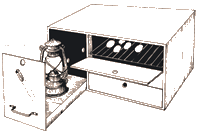In Benin recently, I came across this good idea for making an incubator for hatching chickens’, ducks’ or other poultry eggs.
The incubator is based around an ordinary kerosene hurricane lamp. However, the reservoir on an ordinary lamp is too small for the purpose of an incubator, which needs continual heat. So the bottom of the normal reservoir is cut off and the lamp welded to a large tank. This tank is then welded to an upright part, making an L-shaped tray which forms the door. This whole lamp unit fits into the incubator at one end. A metal pipe goes straight into the reservoir so it can be refilled without removing the lamp. There is also a small hole to check that the lamp is burning correctly.
The main part of the incubator is an oblong box made of wood and metal. If the end containing the lamp is lined with metal, this reduces the fire risk. There is an upper tray made with wire grid (the kind used for mosquito netting) with a door large enough to slide the tray in and out. The lower compartment can be used to keep chicks warm after hatching – this also has a small door. Covering the back, top and sides with some kind of insulating material – old blankets, newspapers or sacking – helps to keep an even temperature. Make sure, though, that air can still reach the lamp.
Ian Wallace










